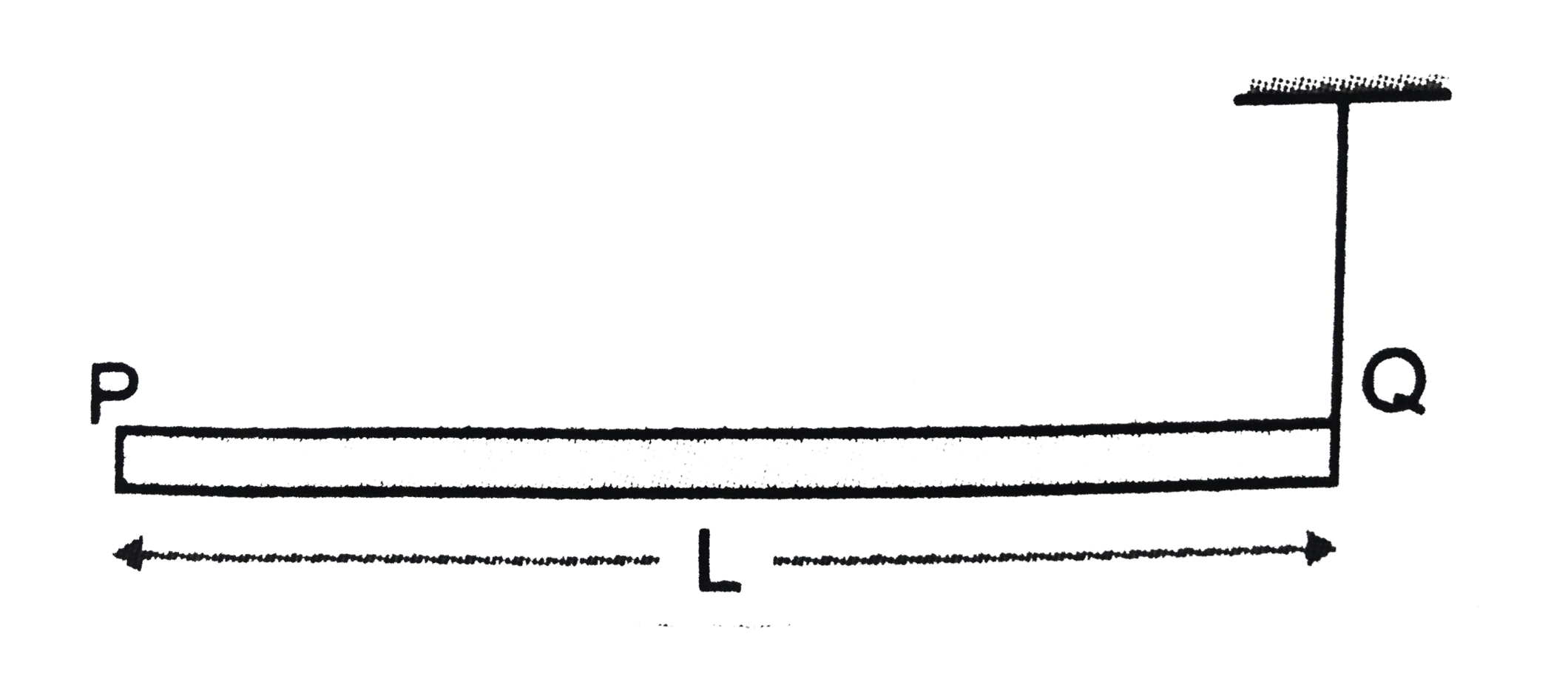A thin, uniform rod with negligible mass and length 0.200m is attached to the floor by a frictionless hinge at point P (as shown in fig) A horizontal spring with force constant k=4.80Nm−1 connects the other end of the rod to a vertical wall. The rod to a vertical wall. The rod is in a uniform magnetic field B=0.340T directed into the plane of the figure. There is current I=6.50 A in the rod, in the direction shown.

Calculate the torque due to the magnetic force on the rod, for an axis at P.
0.0442Nm−1, clockwise
0.0442Nm−1, anticlockwise
0.022Nm−1, clockwise
0.022Nm−1, anticlockwise
The correct Answer is:A
By exmining a small piece of the wire Fig. we find:

Dividing the rod into infinitiesimal sections of length dr.
The magnetic force on this section is dF1=IBdr and is
perpendicular to the rod. The torque dt due to forceon this section
is dtau=rdF1=IBrdr
The total torque is
∫dr=IB∫10rdr=12Il2B=0.0442Nm−1,
clockwise. This is the same torque calculated from a force diagram
in which the total magnetic force F1=ILB acts at the centre of
the rod.
F1 produces a clockwise torque, so the spring force must produce
a couterclockwise torque. The spring force must be to left,
the spring is stretched:
axis at hinge, counterclockwise torque positive
(kx)lsin53∘−12Il2B=0
x=IlB2ksin53.0∘=(6.50A)(0.200m)(0.340T)2(4.80Nm−1)sin53.0∘
=0.05765m
Topper's Solved these Questions
- MAGNETIC FIELD AND MAGNETIC FORCESBOOK - CENGAGE PHYSICSCHAPTER - MAGNETIC FIELD AND MAGNETIC FORCESEXERCISE - Exercises Integer
7 Videos
- MAGNETIC FIELD AND MAGNETIC FORCESBOOK - CENGAGE PHYSICSCHAPTER - MAGNETIC FIELD AND MAGNETIC FORCESEXERCISE - Archives Fill In The Blank
6 Videos
- MAGNETIC FIELD AND MAGNETIC FORCESBOOK - CENGAGE PHYSICSCHAPTER - MAGNETIC FIELD AND MAGNETIC FORCESEXERCISE - Exercises Assertion -reasoning
8 Videos
- KINETIC THEORYBOOK - CENGAGE PHYSICSCHAPTER - KINETIC THEORYEXERCISE - Question Bank
31 Videos
- Magnetism and MatterBOOK - CENGAGE PHYSICSCHAPTER - Magnetism and MatterEXERCISE - Question Bank
50 Videos
Similar Questions
A rod PQ of mass M and length L is hinged at end P. The rod is kept horizontal by a masseless string tied to point Q as shown in Fig. When string is cut, the initial angular acceleration of the rod is :

View SolutionA rod PQ of mass M and length L is hinged at end P. The rod is kept horizontal by a massless string tied to point Q as shown in the figure. When string is cut, the initial angular accleration of the rod is.

View Solution
Knowledge Check
A thin, uniform rod with negligible mass and length 0.200m is attached to the floor by a frictionless hinge at point P (as shown in fig) A horizontal spring with force constant k=4.80Nm−1 connects the other end of the rod to a vertical wall. The rod to a vertical wall. The rod is in a uniform magnetic field B=0.340T directed into the plane of the figure. There is current I=6.50 A in the rod, in the direction shown.

When the rod is in equilibrium and makes an angle of 53.0∘ with the floor, is the spring stretched or compressed?A0.05765m,stretchedB0.05765m,compresedC0.0242m,stretchedD0.0242m,compresedA thin uniform rod with negligible mass and length l is attached to the floor by a frictionless hinge at point P. A horizontal spring with force constant k connects the other end to wall. The rod is in a uniform magnetic field B directed into the plane of paper. What is extension in spring in equilibrium when a current is passed through the rod in direction shown? Assuming spring to be in natural length initially and it remains perpendicular to wall always.
 A5ilB8kB3ilB8kC5ilB4kD5ilB6k
A5ilB8kB3ilB8kC5ilB4kD5ilB6kA rod PQ of mass M and length L is hinged at end P. The rod is kept horizontal by a massless string tied to point Q as shown in figure. When string is cut, the intial angular acceleration of the rod is
 A3g2LBgLC2gLD2g3L
A3g2LBgLC2gLD2g3L
A conducting rod of length l is hinged at point O. It is a free to rotate in a verical plane. There exists a uniform magnetic field B in horizontal direction. The rod is released from the position shown. The potential difference between the two ends of the rod is proportional to

View SolutionA uniform rod of mas m is moving with constant velocity v0 in a perpendicular uniform magnetic field B as shown. The resistance of rod is r . The current flowing through rod, RI and R2 will be

View SolutionA conducting rod of length l is higed at point O. It is free to rotate in a vertical plane. There exists a uniform magnetic field →B in horizontal direction. The rod is released from the position shown in figure. Potential difference between the two ends of the rod is proportional to
View SolutionA uniform rod of mass m length l is attached to smooth hinge at end A and to a string at end B as shown in figure. It is at rest. The angular acceleration of the rod just after the string is cut is :

View SolutionA conducting rod of length l is hinged at point O. It is a free to rotate in a verical plane. There exists a uniform magnetic field B in horizontal direction. The rod is released from the position shown. The potential difference between the two ends of the rod is proportional to

View Solution
